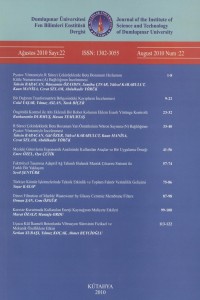Öz
Experimental design is a
statistical method which is commonly used to reveal the variability in and
detect the effective factors on production processes. But, “Fuzzy Logic” method
anf Fuzzy set theory is also rise up as an approach to reveal the variability
in and detect effective factors on ptoduction proceses. In this study, the aim is to
examine the possibility of obtaining the same information from experimental
design by ANFIS model. As a result of the two application, it’s seem that
effective factors obtained from experimental design, be also obtained ANFIS
model with smaller error values than experimental design.
Anahtar Kelimeler
Adaptive neuro fuzzy inference system (ANFIS) Experimental design Memebership function
Kaynakça
- [1]Türkbey, O., “Makina sıralama problemlerinde çok amaçlı bulanık küme yaklaşımı”, Gazi Üniversitesi, Müh. Mim. Fakülte Dergisi, 18:Ankara, 63-77, (2003).
- [2]Elmas, Ç.,” Bulanık mantık denetleyiciler”, Seçkin Yayıncılık, Ankara, (2003).
- [3]Taheri, S.M., “Trends in fuzzy statistics”, Austrian Journal of Statistics, 32:, 239-257,(2003).
- [4]Kim, B., Park, J.H., “Qualitative fuzzy logic model of plasma etching process”, IEEE Transactions on Plasma Science, 30: 673-678, (2002).
- [5]Yılmaz, N.A.Ş., Alparslan, F.N. and Jain, L., “ANFIS-unfolded –in-time for multivariate time series forecasting”, Neurocomputing, 61: 139-168, (2004.)
- [6]Tseng, F.M., Tzeng, G.H., Yu, H.C. and Yuan, B.J.C., “Fuzzy ARIMA model for forecasting the foreign exchange market”, Fuzzy Sets and Systems, 118: 9-19, (2001).
- [7]Chiang, D.A., Lin, N.P., “Correlation of fuzzy sets”, Fuzzy Sets and Systems, 102: 221-226, (1999).
- [8]Tanaka, S.U., Asai, K., “Fuzzy linear regression model”, IEEE Trans.System Man Cybernet, 10: 2993-2938, (1980).
- [9]Yang, M.S., Liu, H.H., “Fuzzy least squares algorithms for interactive fuzzy linear models”, Fuzzy Sets and Systems, 135: 305-316, (2003).
- [10]Grezegorzewski, P., “Testing statistical hypotheses with vague data”, Fuzzy Sets and Systems, 112: 501-510, (2000).
- [11]El-Shal, S.M., Morris, A.S., “A fuzzy rule based algorithm to the performance of statistical process control in quality systems”, Journal of Intelligent and Fuzzy Systems, 9: 207-223, (2000).
- [12]Çömlekçi, N., “Deney Tasarımı ve Çözümlemesi”, TC Anadolu Üniversitesi Eğitim, Sağlık ve Bilimsel Araştırma Çalışmaları Vakfı Yayınları, Eskişehir, (1988).
- [13]Apaydın, A., Kutsal, A. ve Atakan, C., “Uygulamalı İstatistik”, Ankara, (1994).
- [14]Montgomery, D.C., “Design and Analysis of Experiments”, 5th Edition, John Wiley & Sons Inc., USA, (2001).
- [15]Cochran, W,G., Cox, G.M., “Experimental Designs”, Wiley Classics Libary Edition Published, USA (1992).
- [16]Timothy, J.R., “Fuzzy Logic with Engineering Applications”, Mc Graw-Hill, Newyork, (1995).
- [17]Klir, J.G., Yuan, B., “Fuzzy Sets and Fuzzy Logic Theory and Applications”, Prentice Hall , New Jersey, (1995).
- [18]Jang, J.S.R., Sun, C.T. and Mizutani, E., “Neuro Fuzzy and Soft Computing a Computational Approach to Learning and Machine Intelligence”, Prentice Hall, USA, (1997).
- [19]Jang, J.S.R., “ANFIS: Adaptive-network based fuzzy inference systems”, IEEE Trans. on Systems, Man and Cybernetics, 23: 665-685, (1993).
- [20] Şentürk, S., “Deney Planlamasında Bulanık Mantık Yaklaşımı”, Doktora Tezi, Anadolu Üniv.Fen Bilm.Ens., (2006).
Öz
Deney planlaması yöntemi
Endüstriyel uygulamalarda üretim süreçlerindeki değişkenliği ortaya koymada ve
üretim süreçlerindeki etkin faktörleri belirlemede oldukça yaygın kullanılan
bir istatistiksel yöntemdir. Ancak “Bulanık Mantık” yaklaşımı ve bulanık küme
teoriside üretim süreçlerindeki değişkenliği ortaya koymada ve üretim
süreçlerindeki etkin faktörleri belirlemede kullanılabilecek farklı bir
yaklaşım olarak karşımıza çıkmaktadır. Bu çalışmada, Adaptif ağ tabanlı
bulanık mantık çıkarım sistemi (ANFIS) modeli ile deney planlamasından elde
edilen bilgilere ulaşmanın mümkün olup olmayacağı araştırılmak istenmiştir. İki
uygulama sonucunda, Deney planlaması ile elde edilen etkin faktörlerin ANFIS
modellemesi ile de elde edilebildiği ve ANFIS modellemesinin Deney
planlamasından daha küçük hata değerine ulaştığı görülmüştür.
Anahtar Kelimeler
Adaptif ağ tabanlı bulanık mantık çıkarım sistemi (ANFIS) Deney planlaması Üyelik fonksiyonu
Kaynakça
- [1]Türkbey, O., “Makina sıralama problemlerinde çok amaçlı bulanık küme yaklaşımı”, Gazi Üniversitesi, Müh. Mim. Fakülte Dergisi, 18:Ankara, 63-77, (2003).
- [2]Elmas, Ç.,” Bulanık mantık denetleyiciler”, Seçkin Yayıncılık, Ankara, (2003).
- [3]Taheri, S.M., “Trends in fuzzy statistics”, Austrian Journal of Statistics, 32:, 239-257,(2003).
- [4]Kim, B., Park, J.H., “Qualitative fuzzy logic model of plasma etching process”, IEEE Transactions on Plasma Science, 30: 673-678, (2002).
- [5]Yılmaz, N.A.Ş., Alparslan, F.N. and Jain, L., “ANFIS-unfolded –in-time for multivariate time series forecasting”, Neurocomputing, 61: 139-168, (2004.)
- [6]Tseng, F.M., Tzeng, G.H., Yu, H.C. and Yuan, B.J.C., “Fuzzy ARIMA model for forecasting the foreign exchange market”, Fuzzy Sets and Systems, 118: 9-19, (2001).
- [7]Chiang, D.A., Lin, N.P., “Correlation of fuzzy sets”, Fuzzy Sets and Systems, 102: 221-226, (1999).
- [8]Tanaka, S.U., Asai, K., “Fuzzy linear regression model”, IEEE Trans.System Man Cybernet, 10: 2993-2938, (1980).
- [9]Yang, M.S., Liu, H.H., “Fuzzy least squares algorithms for interactive fuzzy linear models”, Fuzzy Sets and Systems, 135: 305-316, (2003).
- [10]Grezegorzewski, P., “Testing statistical hypotheses with vague data”, Fuzzy Sets and Systems, 112: 501-510, (2000).
- [11]El-Shal, S.M., Morris, A.S., “A fuzzy rule based algorithm to the performance of statistical process control in quality systems”, Journal of Intelligent and Fuzzy Systems, 9: 207-223, (2000).
- [12]Çömlekçi, N., “Deney Tasarımı ve Çözümlemesi”, TC Anadolu Üniversitesi Eğitim, Sağlık ve Bilimsel Araştırma Çalışmaları Vakfı Yayınları, Eskişehir, (1988).
- [13]Apaydın, A., Kutsal, A. ve Atakan, C., “Uygulamalı İstatistik”, Ankara, (1994).
- [14]Montgomery, D.C., “Design and Analysis of Experiments”, 5th Edition, John Wiley & Sons Inc., USA, (2001).
- [15]Cochran, W,G., Cox, G.M., “Experimental Designs”, Wiley Classics Libary Edition Published, USA (1992).
- [16]Timothy, J.R., “Fuzzy Logic with Engineering Applications”, Mc Graw-Hill, Newyork, (1995).
- [17]Klir, J.G., Yuan, B., “Fuzzy Sets and Fuzzy Logic Theory and Applications”, Prentice Hall , New Jersey, (1995).
- [18]Jang, J.S.R., Sun, C.T. and Mizutani, E., “Neuro Fuzzy and Soft Computing a Computational Approach to Learning and Machine Intelligence”, Prentice Hall, USA, (1997).
- [19]Jang, J.S.R., “ANFIS: Adaptive-network based fuzzy inference systems”, IEEE Trans. on Systems, Man and Cybernetics, 23: 665-685, (1993).
- [20] Şentürk, S., “Deney Planlamasında Bulanık Mantık Yaklaşımı”, Doktora Tezi, Anadolu Üniv.Fen Bilm.Ens., (2006).
Ayrıntılar
| Birincil Dil | Türkçe |
|---|---|
| Konular | Mühendislik |
| Bölüm | Makaleler |
| Yazarlar | |
| Yayımlanma Tarihi | 15 Ağustos 2010 |
| Yayımlandığı Sayı | Yıl 2010 Sayı: 022 |


